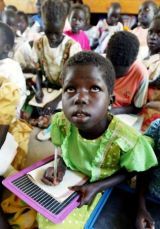Education, the staring point of sothern Sudan reconstruction
By Swangin Bismarck*
Nov 19, 2005 (RUMBEK) — She speaks with a deep smile that would make one feel she has no concerns, but 12 year old Sarah Adol is only delighted because she is in school.

|
|
A Sudanese girl listens to her teacher as she attends a class along with over 150 other girls at Rumbek primary school in Southern Sudan April 19, 2004. |
In a region where school enrolment is disturbingly 20%, many children especially girls are tempted into marriage.
Sarah Adol is in primary two in Bunagok primary school, one of UNICEF’s efforts to provide education to children whose future without education is at stake.
“I want to become a teacher if I complete my studies” said Adol. “That is why I come daily to school”, she added while shyly opening the pages of her exercise book, courtesy of UNICEF’s education kit.
As she treks the two hours journey from Apoor village to school, she drags along her younger sister who attends a primary one class under a three.
The school building only accommodates the three grades of Primary one to three while the pre-primary class undertakes lessons under a tree, which only takes a drop of rain to dispatch the pupils.
In an environment where girls are viewed as source of wealth and domestic caterers, 11 year old, Mary Nyaut wonders whether she can realize her dream of becoming a nurse.
After only attending first term of primary one in Diocese of Rumbek primary school, she was retrieved from school to a cattle camp by the father. “I was milking the cattle and prepare the milk for my father”, she said. “And I was annoyed [for being taken out of school]”, she quickly added.
Still downing her traditional cattle camp attire, she managed to sneak from the cattle camp to continue her school but she is afraid of the fathers’ wrath.
Nyaut has to stay in the school for another one hour after school everyday so as to revise her notes as end of year exams approach.
“I missed two terms, but I want to pass”, she said. Such is the drive that keeps her coming daily to school though she has to take care of her sick mother.
She says she wants to have a bright future but the obstacles on the education path are many.
A fact-finding study showed that many parents fear sending their daughters to school for security and cultural reasons, or because their girls may no longer have time to help with the housework.
The school in Bunagok was constructed by Collaborazione Comitato Medica (CCM), an international organization under the funding of UNICEF’s Quick Start Community Improvement Project(QS-CIP), a programme launched in 2003 designed by donors to provide rapid, visible and tangible benefits to the people of Southern Sudan by building the capacity of local authorities and the Sudan relief and Rehabilitation Commission(SRRC) the SPLM humanitarian wing to manage service delivery and by supporting Community Based Organisations, and local and international non governmental organisations to rehabiliate war torn Southern Sudan
Specialized girls schools established by UNICEF helped narrow down the girl child education gap but with the signing of a peace agreement early this year prompting mass movements the demand for more schools is high.
One recent attempt to rescue Southern Sudan’s future was an Education, Reconstruction and Development Forum (ERDF) held in Rumbek from November 3.
The workshop which drew all education stakeholders predicts a promising future for southern Sudan’s education system and an opportunity for millions of children who have already lost an opportunity too many.
“Sudan can not afford to loose another generation” said Education Minister Dr Michael Milli Hussein. He appreciated the firm commitment of UNICEF as the education lead agency and the rest of the NGO community for the clear thinking.
The forum sets a firm base that will chart the way forward as UNICEF and partners struggle to enable access to school for every child in Southern Sudan.
A Go to School campaign is in the offing in which UNICEF and partners will strive to break the cultural and traditional bondages that held many children out of school.
In southern Sudan boys will be assigned cattle keeping while girls, often looked in terms of wealth during marriage are overwhelmingly laden with domestic work.
The Go to school strategy suggests being a multiple option strategy exploring all possibilities for all children to get to school.
Without education, South Sudan’s future remains bleak. When one piece of the mosaic cracks, there is a danger everything else could fall apart. This is the tricky situation threatening the future of Southern Sudan, a region with a decimal 20% literacy rate of its estimated 7.5 million people.
* Bismarck Assistant communication officer, Unicef, southern Sudan
